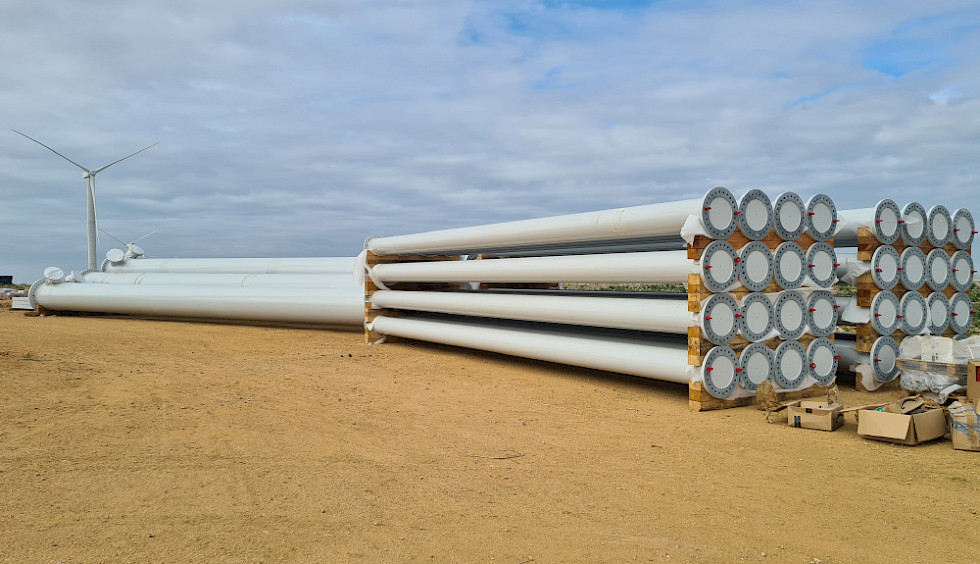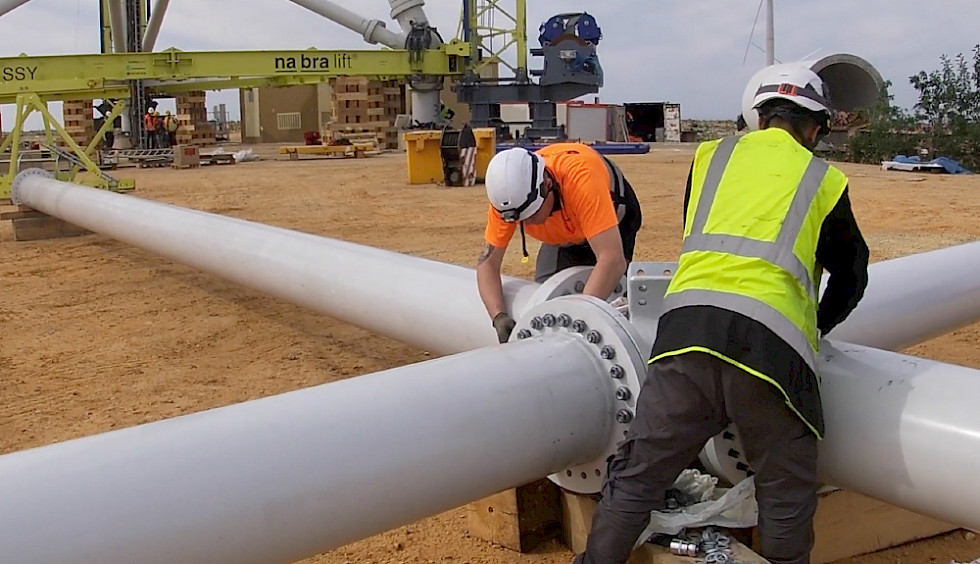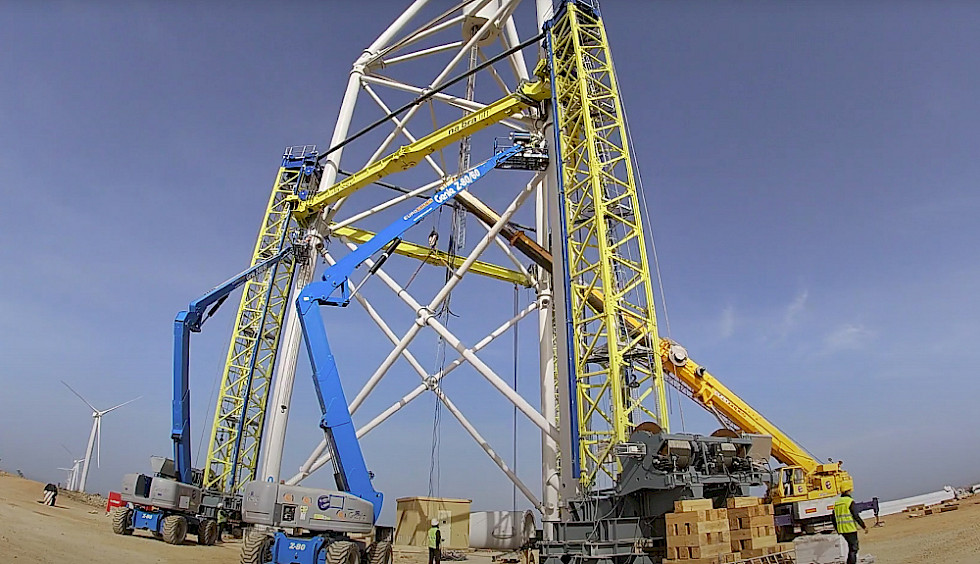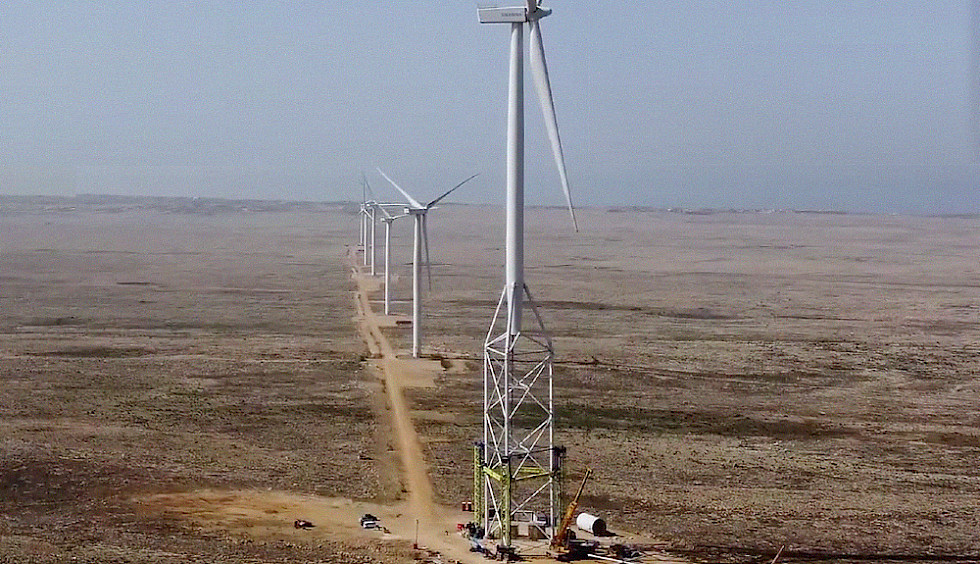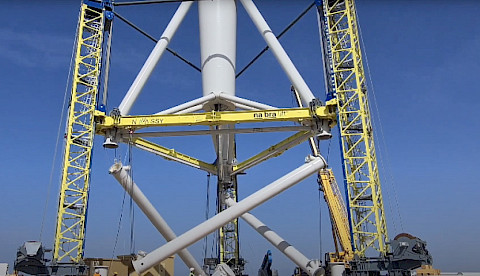Rethinking the Design from the Bottom up
The Spanish company Nabrawind – Advanced Wind Technologies has developed a new approach to the construction of onshore wind turbines. Part of the solution is steel tubes from Mannesmann Line Pipe, and a new record was set in the very first project.

"As a technician, of course, you’re always thrilled when innovations make it to market. And all the more gratifying when our HFI-welded tubes have a hand in it."Kevin Kroh, Product Manager Mannesmann Line Pipe
Nabrawind’s engineers set themselves the overriding goal of significantly reducing the cost of manufacture, transport and assembly of onshore wind turbines. The fact that the carbon footprint can also be reduced at the same time is a positive side effect that also makes the new process more eco-friendly.
Questioning standard practice
The conventional approach to the installation of wind turbines is to first erect the complete turbine tower and then to erect the rotor and turbine using one or even several cranes specifically designed for extreme heights and high tonnages. This is a technically elaborate and highly ambitious undertaking, which more often than not is interrupted by the prevailing winds and, given an installation height of usually well over 100 m, is obviously not without its dangers.
"There’s got to be another way to do this," the engineers at Nabrawind thought to themselves and called the existing approach completely into question, or rather, turned it on its head. Because the construction of a wind turbine with the Nabralift system also starts at the bottom, but with the top of the tower and the rotor first.
New design, new system
The Nabralift tower represents a completely new technological approach in terms of both design and erection. The design consists of a triple-column structure installed under the drive unit. This eliminates most of the tower required for conventional installations and offers a number of benefits. This is because the tower is the largest and heaviest part of a wind turbine. Weighing several hundred tons, it contributes about 15 to 25% of the cost of a wind turbine and also accounts for a large proportion of the assembly and transport costs.
But the real innovation of Nabrawind’s engineers is its self-erection system (SES), which allows the installation of a complete wind turbine without the deployment of cost-intensive specialized crane equipment. And it does so even at Beaufort wind forces 6 to 7, which with conventional construction methods cause costly downtime and erection stoppages.
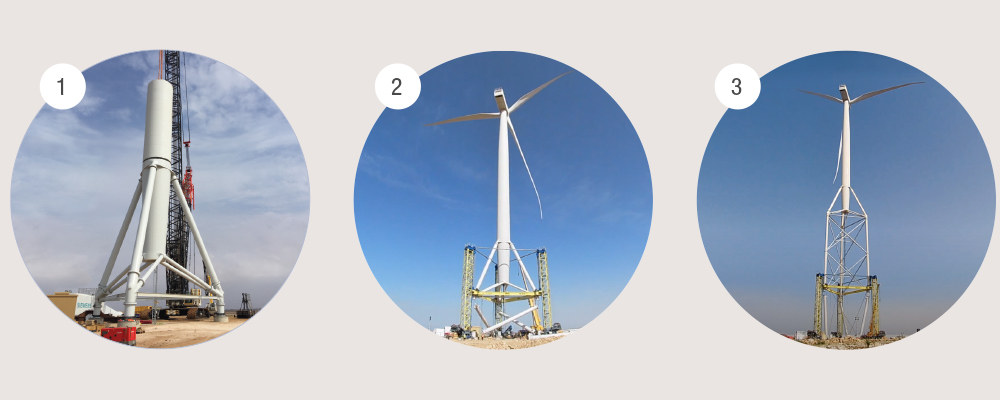
1 | Erection with the Nabralift system: First, the top of the tower is connected to the triple-member tower transition unit.
2 | Once the nacelle, tower slewing ring and rotor is connected to the tower ...
3 | ... the SES (self-erection system) lifts the structure weighing hundreds of tons into the air until the target height is reached.
Benefits for foundation work, logistics and site setup
Depending on the height of the tower, the three-legged tower design involves far less material and weight than conventional construction methods and can therefore also be installed on a new foundation design. This reduces costs and accelerates execution. There is enormous potential for savings in concrete alone, depending on the height of the tower and the soil conditions.
The use of much smaller components that can be pre-produced in series simplifies the entire supply and logistics chain and significantly reduces the number of oversized loads that have to be transported. Stockyard requirements are also not as complex, and site setup and management also benefit from the new process.
Erection from the bottom up
The erection of a Nabralift tower starts with the top of the tower tube, which is connected to the tower transition unit. Then the nacelle and the tower slewing ring with the rotor blades are fitted to the tower.
The SES then comes into play, lifting the entire upper turbine unit 17 m into the air. Then the tower columns, each 16 meters tall, are positioned beneath and connected to the upper turbine unit. The supporting three-legged design structure is then stiffened with X-type bracing.
In a second lift, another 16 m of height is gained, and the same cycle of lifting, connecting and bracing continues until the desired final height is reached. Within three days, a tower is thus erected to a height of 140 m without the need for a large, heavy-duty crane.
Sought and found
In August 2018, Nabrawind erected the first Nabralift tower in Eslava, Spain, near Pamplona, initially just to test the design and try out the SES.
The findings resulted in the optimization of the tower design with regard to the X-type bracing for the first wind turbine specifically designed for the Oualidia Wind Farm in Morocco. In contrast to the original tube geometry, which envisaged tapered ends of the bracing tubes, flanges with matching bolt hole rims were now to be used for precision bolting.
Kevin Kroh, who oversaw the project from the outset as product manager for Mannesman Line Pipe, recalls: "The challenge was to precisely match the manufacturing tolerances in terms of pipe ovality and diameter to the tolerances of the flanges so that they would fit perfectly when subsequently welded on."
Working together with the creative team at Nabrawind, they therefore discussed the technical possibilities and the advantages of the HFI welding process in this context. "The novel design and the new construction method were of course motivation enough for us to want to make and deliver the required quality," says Kroh. "Especially in view of the fact that this was also the first time we have been asked to supply an onshore wind turbine."
The dimensions calculated for the tubes for the X-type tower bracing resulted in a diameter of 406.4 mm with wall thicknesses of 12 mm. They were manufactured in lengths of 10.46 m. However, short tubes were also needed as transition pieces between the bracing and the corners of the tower structure. This application required a wall thickness of 25.4 mm for the same diameter. In mid-2021, the tubes left Hamm and Siegen by truck for Spain, where they were further processed, blasted and painted for assembly.
Nabralift tower premiere in Morocco
At Oualidia Wind Farm operated by the French project developer InnoVent in Morocco, Nabrawind has now realized its first commercial wind turbine with the Nabralift system. The installation of the 3.6 MW wind turbine was accomplished with self-erection of the complete turbine. "During the process, Nabrawind’s self-erecting system lifted the 700-tonne turbine in strong wind conditions, with gusts of up to 15m/s, proving the ability of this new patented process to minimize project delays due to strong winds," the Spanish company reported on its website in February 2022.
Africa’s tallest wind farm
"This milestone completes the installation of the first Nabralift tower in Africa and confirms all this new tower technology’s key advantages: significant mass reduction of steel and concrete both in the tower and foundation, craneless self-erection, removal of logistics barriers and minimal environmental footprint," the press release continues.
"As a technician, of course, you’re always thrilled when innovations make it to market," says Kroh. "And all the more gratifying when our HFI-welded tubes have a hand in it." And with a record at the first attempt. Its hub height of 144 meters makes the Nabralift tower Africa’s tallest onshore wind turbine.
For Mannesmann Line Pipe, it is also a more than successful debut in a potential new business segment.

